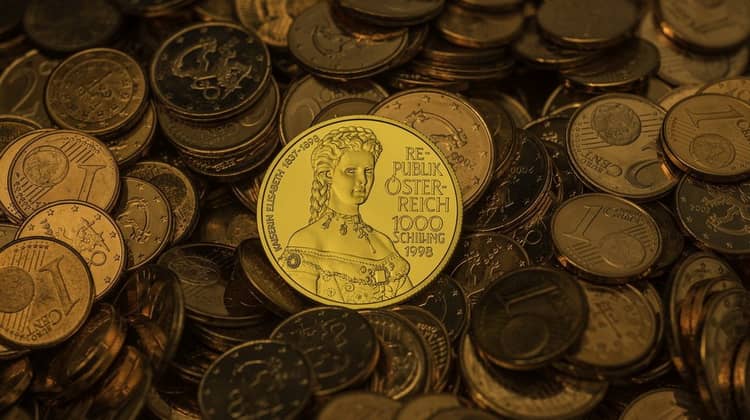
Gold and silver shilling of Austria is the national currency of the Austrian Republic. The coins were introduced into circulation on March 1, 1925. They replaced the devalued Austrian corona. The currency was in use until 1938 and was considered one of the most stable in Europe. You can find all Austrian Gold and Silver coins in our catalog.
In following years, when the country became a part of Germany, it was replaced by the Reichsmark. In 1945, the shilling was returned into circulation, but they were minted from nickel, aluminum and copper. In 2002, they were replaced by euro.
History
Ausrtrian shillings from gold and silver – one of the most valuable coins with a rich history. It is due to the fact that the they appeared in a rather difficult period both for Austria and Europe.
After the end of World War I the Austro-Hungarian Empire collapsed. But a common currency – corona was still issued in both countries. In September 1922 the government was able to obtain financial assistance from the League of Nations, which led to the creation of the Central Bank.
Leopold Fortsner (well-known Austrian artist who succeeded in decorating temples) wrote in a note addressed to a priest from Schwaz that the frame of the Franciscan monastery in Vienna would cost a considerable amount of money to the Holiness – 1,000 shillings (accounted for July 3, 1925). This amount included the design of the altar and the artistic decoration of the room.
This was a significant step towards the economic development of Austria after the military failure. The first national currency appeared in 1924. The issue of the legendary coin 20 Austro-Hungarian coronas was ended around the same year. Shillings were minted from bronze, copper-nickel alloy and silver.
The presence of precious metals in money production indicated that the economy was becoming more stable. Soon Austria paved the way for membership in the international currency fund and the silver schillings themselves in Austria were called the “Alpine dollar”.

The Austrian parliament authorized the issue of silver and gold coins with different denominations:
- 1/2 shilling (1925) – 64% silver;
- 1 shilling (1925) – 64%, (1935) – 75% silver;
- 2 shillings(1937) – 64% silver;
- 5 shillings (1934) – 83% silver;
- 25 shillings(1926) – 90% gold;
- 100 shillings (1924) – 90% gold.
The Central Bank kept the stable cost of shilling by making a decision to conduct monetary policy. In 1976 this led to the binding of the exchange rate to the German mark. Constantly adapting to changing market conditions the country (by the beginning of the 1990s) achieved a high degree of monetary integration within the international economic community. The Austrian gold shilling enjoyed stability until it was replaced by the euro in 2002.
Mintage
One of the first coins of the First Republic – 1/2 Austrian shilling – was issued in 1925 (22,763,000 copies) and in 1926 (8,550,000 copies).

Austrian shilling in different years had a very different mintage:
- mintage in 1924 (11,086,000 copies), cost 4-15$;
- mintage in 1925 (38,209,000 copies), cost 5-9$;
- mintage in 1926 (20,157,000 copies), cost 5-8$;
- mintage in 1934 was made only in a copper-nickel alloy and was slightly larger than its predecessors (7 g instead of 6 g, which makes it easier to compare coins, apart from, of course, the difference between the obverse and the reverse)
Austrian shillings were issued in the form of commemorative coins in small mintages (from 500,000 to 1,500,000 copies) from 1928 to 1938. There are 10 different kinds of commemorative coins. They all were dedicated to some memorable dates.
The so-called “double shilling” or “doppelschilling” has an extremely entertaining story. In order to create an appearance of the growth of Austrian economy the issue of silver coins of the denomination mentioned above started in 1928. It continued until 1938. Every year was memorable in its own way. Years from 1928 to 1932 were given to scholars and artists.Franz Schubert coin was minted first dedicated to the one hundredth anniversary of the death of the musician.
After this, two-shilling coins were produced with images of the surgeon Theodor Bilroth, the minstrel Walter von der Vogelweide, the composers of Mozart and Haydn. There`re the coats of arms of the nine federal states of Austria, the coat of arms of Vienna were minted, and the name of the state was “REPUBLIK ÖSTERREICH” on the reverse of these coins.
However, in 1937, they began to portray politicians: Ignaz Seipel, Engelbert Dollfus and others. The last coin was issued for the 200th anniversary of the completion of the construction of the St. Charles church and, worth noticing, was noteven named in honor of the architect.
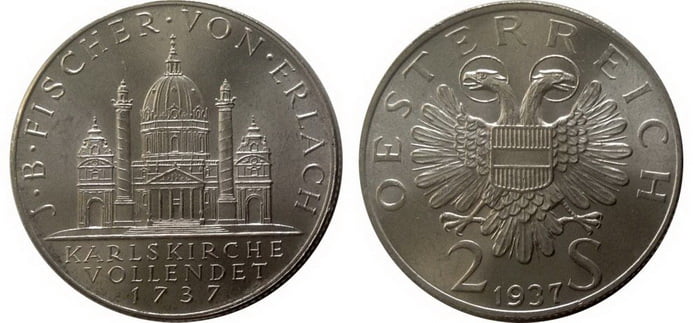
Thus, it stressed the obvious link between the Catholic Church and the newly-founded state. These coins depicted a two-headed eagle – the Austrian coat of arms of 1934 and the name of the state “ÖSTERREICH”. The rarest of the coins issued is two shillings depicting Joseph Haydn. All coins were minted from silver of 640 samples with a diameter of 30 mm and weight of 12 grams.
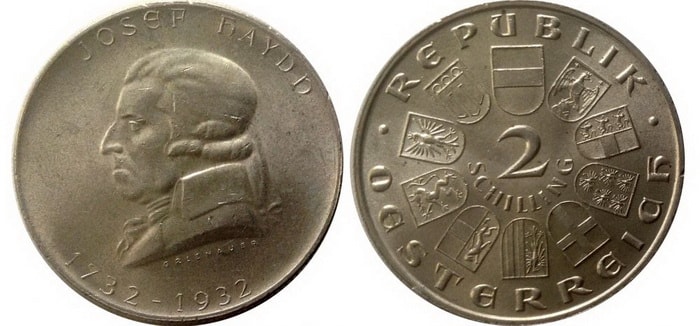
A coin of 5 shillings in denomination was issued in years from 1934 to 1936 with circulation from 1,500,000 to 5,300,000 copies.
In 1933, university professors earned between 5,500 and 12,000 Austrian shillings a year. At the same time, two of the largest scientists – Emil Goldmann and Heinrich Gomperz – reported income approximately of 14,000 Austrian shillings a year. Friedrich Engel-Janosi – the owner of one large enterprise – in addition to his post at the university, reported an income of 16,000 shillings a year before his deportation from the Austrian Republic.
25 Austrian shillings is one of the few gold coins issued in Austria in very small quantities. From 1925 to 1931 from 72,000 to 276,000 copies were issued, which is why they have a relatively high cost (5.881 g of gold).
In 1976, the Austrian Mint issued a gold coin of 1000 shillings to commemorate the 1000th anniversary from the beginning of the Babenberg dynasty. This was the first time of issuing a coin with such a high denomination in this country.
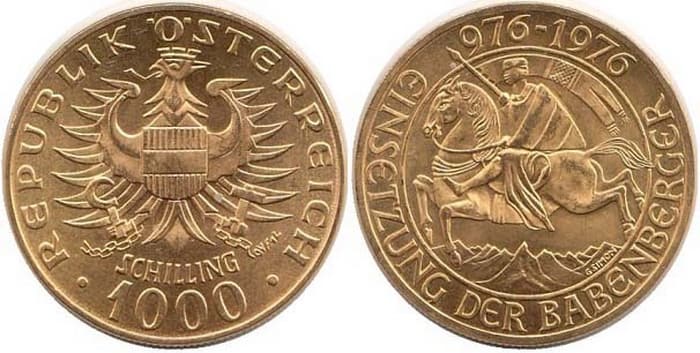
Also, the Austrian Mint issued 50, 100, 200, 1000 and 2000 shillings of gold , but coins were rarely used for real deals. Also you can find 25 Schilling and 500 Schilling Austrian gold coins in our catalog.
Design
1/2 Austrian shilling denomination of 1925-1926
- Diameter: 19 mm.
- Thickness: 1.5 mm.
- Weight: 3 g.
- Metal: 64% silver, 36% copper.
- Edge: reeded.
- Obverse: There’s an inscription «HALB SСHILLING». In the center there’s a square turned for 45°, in which there’s a face value in the form of a simple fraction divided by a horizontal line (the year of minting is at the bottom).
- Reverse: There’s an inscription «ÖSTERREICH REPUBLIK» and a distinctive coat of arms in the center.
- Engraver: Philipp Häusler (both sides).

1 Austrian shilling denomination of 1924
- Diameter: 26 mm.
- Thickness: 1.6 mm.
- Weight: 7 g.
- Metal: 80% silver, 20% copper.
- Edge: reeded.
- Obverse: There`s an inscription «EIN SСHILLING». In the center there’s a coat of arms against the background of edelweiss twigs.
- Reverse: There’s an inscription «OESTERREICH REPUBLIK» and the Parliament building in Vienna in the center. There’s a year of minting at the bottom.
- Engraver: Heinrich Zita (both sides).
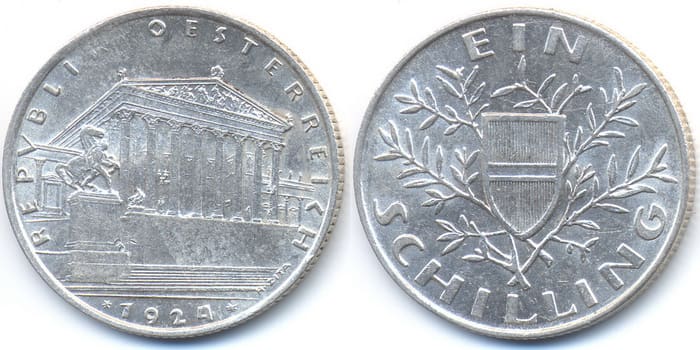
1 Austrian shilling denomination of 1925
- Diameter: 25 mm.
- Thickness: 1.6 mm.
- Weight: 6 g.
- Metal: 64% silver, 36% copper.
- Edge: reeded.
- Obverse: There’s an inscription «EIN SСHILLING». A coat of arms is against the background of edelweiss twigs in the center.
- Reverse: There’s an inscription «ÖESTERREICH REPUBLIK». In the center there’s a building of the Parliament in Vienna. The year of minting is at the bottom.
- Engraver: Heinrich Zita (both sides).
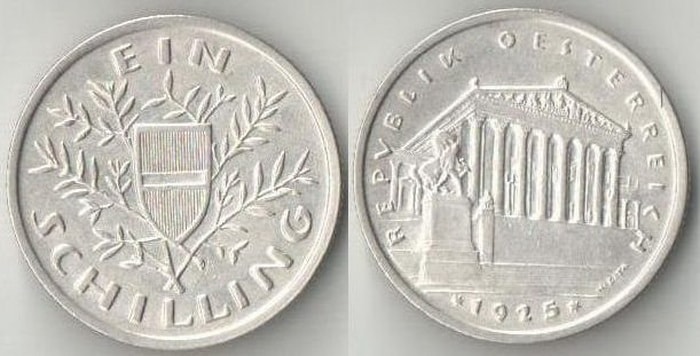
2 Austrian shilling denomination of 1928-1933
- Diameter: 29.4 mm.
- Thickness: 1.7 mm.
- Weight: 12 g.
- Metal: 64% silver, 36% copper.
- Edge: reeded.
- Obverse: There’s an inscription «ÖESTERREICH REPUBLIK» and there are 9 coats of arms of different regions of Austria around the center, in which the face value is engraved.
- Reverse: It depends on the date of the anniversary and a year of issue (see the history of “doppelshilling”).
- Engraver: Edwin Grienauer until 1932, 1933 – Eduard Hanisch-Concée.
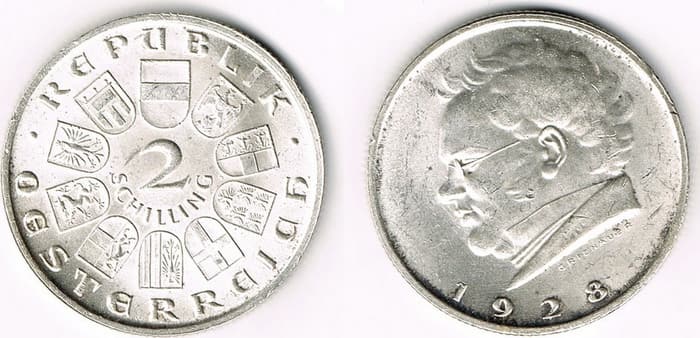
2 Austrian shilling denomination of 1934-1937
- Diameter: 29.4 mm.
- Thickness: 1.7 mm.
- Weight: 12 g.
- Metal: 64% silver, 36% copper.
- Edge: reeded.
- Obverse: There’s an inscription «ÖESTERREICH» and a two headed eagle with a coat of arms. The year of minting and the face value are at the bottom.
- Reverse: It depends on the date of the anniversary and a year of issue (see the history of “doppelshilling”).
- Engraver: 1934 – Edwin Grienauer, 1935 – Rudolf Marshall, 1936 and further – Edwin Grienauer.
Austrian 2 Shilings 1934 silver coins in GoldAdvert catalog.
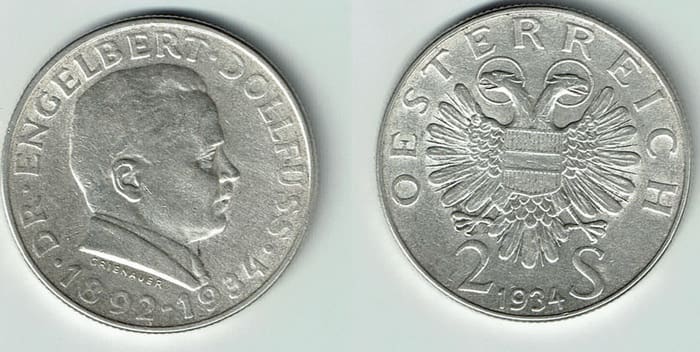
5 Austrian shilling denomination of 1934-1936
- Diameter: 31 mm.
- Thickness: 1.7 mm.
- Weight: 15 g.
- Metal: 83.5% silver, 16.5% copper.
- Edge: inscription with a pattern.
- Obverse: There are an inscription «ÖESTERREICH», a face value in words «FÜNF SСHILLING» and a two headed eagle with the coat of arms in the center.
- Reverse: There is an inscription «MAGNA MATER AUSTRIA» and the image of the Virgin Mary (the year of issue is at the bottom).
Austrian 5 Shilings silver coins in GoldAdvert catalog.
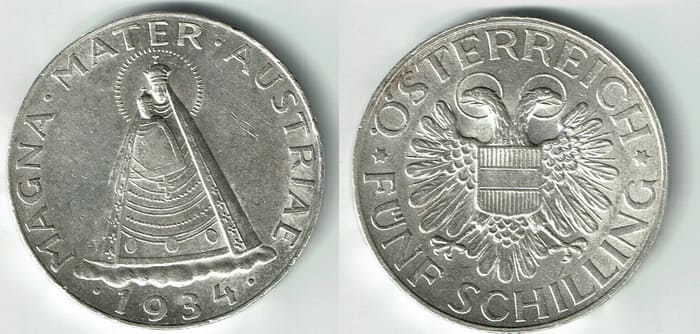
25 Austrian shilling denomination of 1926-1938
- Diameter: 21 mm.
- Thickness: 1.6 mm.
- Weight: 5.9 g.
- Metal: 90% gold, 10% copper.
- Edge: reeded.
- Obverse: The Imperial Eagle of the Republic of Austria with the words «REPUBLIK ÖSTERREICH» is depicted on a gold coin of 25 shillings. The chest of the eagle is covered with a shield, it holds a sickle and a hammer in its clutches.
- Reverse: The face value is indicated – 25 SCHILLING.It is decorated with edelweiss twigs on both sides. There`s a year of minting with wheat spikes at the bottom of the coin.
- Engraver: Arnold Hartig.
Austrian 25 Shilings gold coins in GoldAdvert catalog.
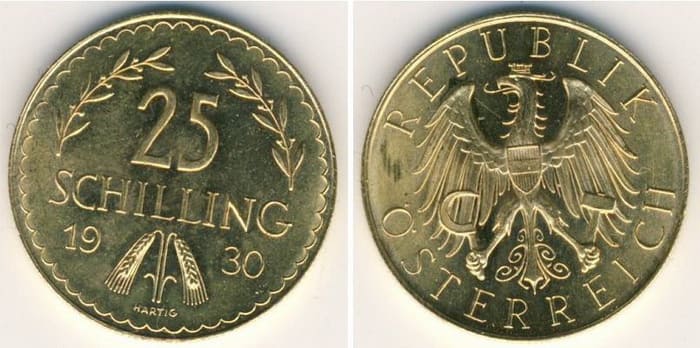
100 Austrian shilling denomination of 1925-1938
- Diameter: 33 mm.
- Thickness: 1.7 mm.
- Weight: 23.523 g.
- Metal: 90% gold, 10% copper.
- Edge: reeded.
- Obverse: There’s a two headed eagle with a shield. It holds a sickle and a hammer in its clutches. An inscription around the eagle is «REPUBLIK ÖSTERREICH».
- Reverse: The year of minting and the face value «100 SCHILLING» are engraved between two thin twigs of edelweiss.
- Engraver: Arnold Hartig.
Austrian 100 Shilings gold coins in GoldAdvert catalog.
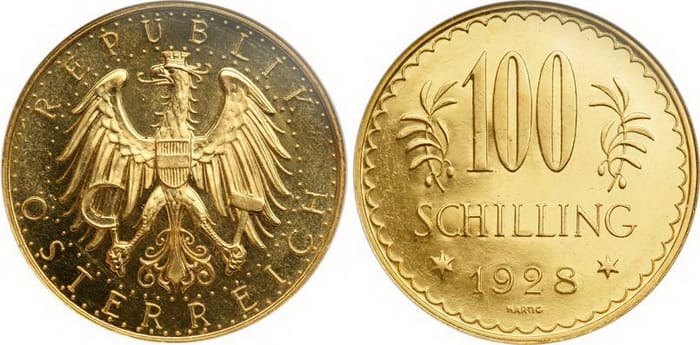
Cost
The price for coins varies depending on the year of issue, the condition of the coin and its denomination. The approximate cost of gold and silver Austrian shillings is:
- 1/2 shilling – cost 2-4$;
- 1 shilling: 1925– 4-15$, 1925 – 5-9$, 1926– 5-8$;
- 2 shillings – cost 11-55$ (depending on specific commemorative coin);
- 5 Austrian shillings cost 16-35$.
The prices for coins of 25 shilling denomination start from 245 dollars and reach 800 US dollars, depending on the condition of the coin.
100 Austrian shillings were issued in 1926 (minted in 1925) in addition to the already existing denomination of 25. The largest of the coins of the First Republic (and of course, the heaviest) was minted until 1938. Its average price varies from 800 to 1,200 $.
In 1938 about 41 shillings per week were enough for Vienna family of 4 people.
Any denomination of Austrian gold and silver shillings is a guaranteed profitable investment. The Mint of this country is one of the most respected organizations in the world, known for their unrivaled quality and craftsmanship in the production of precious metal coins. Beautifully decorated coins, which reflect the history of the country, will be an interesting addition to any collection.
Comments
No commens yet.